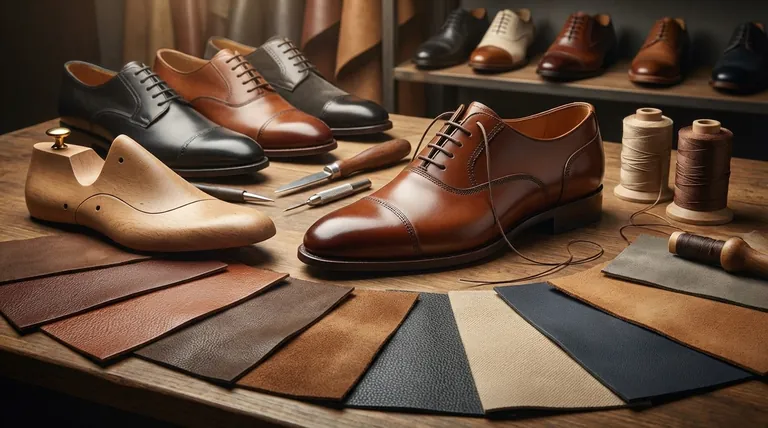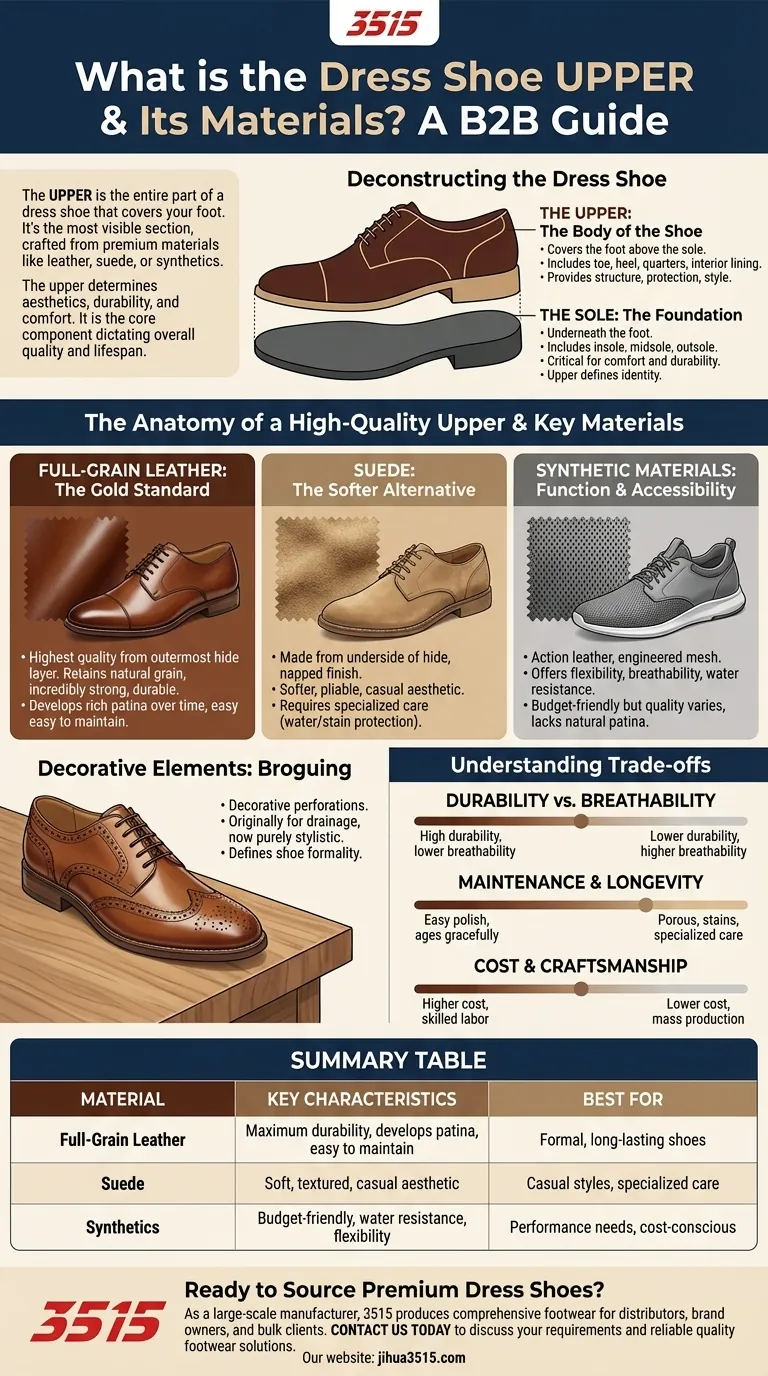The upper is the entire part of a dress shoe that covers your foot. It is the most visible section of the shoe and is typically crafted from materials like high-quality leather, suede, or modern synthetics. The choice of material for the upper is the primary factor determining the shoe's aesthetics, durability, comfort, and character.
The upper is not just the "top" of the shoe; it is the core component that dictates the shoe's overall quality and lifespan. Understanding its materials is the key to distinguishing a well-made shoe from a disposable one.

Deconstructing the Dress Shoe: Upper vs. Sole
A dress shoe is fundamentally composed of two main parts. This simple division helps clarify the function of each component.
The Upper: The Body of the Shoe
The upper encompasses everything above the sole. This includes the toe, the heel, the quarters (sides), and the interior lining that makes contact with your foot. Its job is to provide structure, protection, and style.
The Sole: The Foundation
The sole is the entire structure underneath your foot. It includes the insole (footbed), the midsole (for cushioning, often cork), and the outsole, which makes direct contact with the ground. While the sole is critical for comfort and durability, the upper defines the shoe's identity.
The Anatomy of a High-Quality Upper
The material of the upper is the most significant indicator of a shoe's quality. Each material offers a different blend of durability, aesthetics, and maintenance requirements.
Full-Grain Leather: The Gold Standard
Full-grain leather is the highest quality leather available, made from the outermost layer of the animal's hide. It retains the natural grain and imperfections, making it incredibly strong and durable.
Over time, full-grain leather develops a rich patina, a unique luster that enhances its appearance. It is also relatively easy to clean and maintain with proper care.
Suede: The Softer Alternative
Suede is a type of leather with a napped, fuzzy finish. It is made from the underside of the hide, making it softer and more pliable than full-grain leather.
Because of its texture, suede is often used for more casual dress shoes or as an accent. It offers a distinct aesthetic but requires more specialized care to protect it from water and stains.
Synthetic Materials: Function and Accessibility
Modern synthetics, including high-quality "action leather" or engineered mesh, offer an alternative to traditional hides. These materials can provide enhanced flexibility, breathability, or water resistance.
While often more budget-friendly, the quality of synthetics can vary dramatically. They typically do not age or develop a patina in the same way as genuine leather.
Decorative Elements: The Role of Broguing
Broguing refers to the decorative perforations you often see on dress shoes, particularly wingtips. Originally designed to allow water to drain from shoes in wet climates, it is now a purely stylistic element. The extent and pattern of broguing often define the formality of the shoe.
Understanding the Trade-offs
Choosing an upper is not just about looks; it's about balancing practical considerations. Each material comes with inherent compromises.
Durability vs. Breathability
Full-grain leather is the undisputed champion of durability and will last for decades with proper care. However, materials like suede or shoes with mesh panels often offer superior breathability at the expense of ruggedness.
Maintenance and Longevity
A smooth, full-grain leather upper can be easily cleaned and polished, helping it resist damage and age gracefully. Suede, in contrast, is porous and susceptible to stains, requiring brushes and protective sprays to maintain its appearance.
Cost and Craftsmanship
The highest quality materials, like full-grain leather, are more expensive and require greater skill to shape and stitch. This is why shoes made from superior materials command a higher price—it reflects both the raw material cost and the craftsmanship involved.
How to Choose the Right Upper for Your Needs
Your choice of upper should align directly with your intended use and priorities.
- If your primary focus is maximum durability and formal settings: Choose a smooth, full-grain leather upper for its longevity and classic appearance.
- If your primary focus is a textured, more casual style: Opt for a suede upper, but be prepared for the specialized maintenance it requires.
- If your primary focus is budget or specific performance like water resistance: A high-quality synthetic material can be a practical and effective choice.
Ultimately, the upper is the heart of the shoe, and selecting the right material is the most important decision you will make when investing in quality footwear.
Summary Table:
| Material | Key Characteristics | Best For |
|---|---|---|
| Full-Grain Leather | Maximum durability, develops a patina, easy to maintain | Formal, long-lasting shoes |
| Suede | Soft, textured, casual aesthetic | Casual styles, requires specialized care |
| Synthetics | Budget-friendly, can offer water resistance or flexibility | Performance needs, cost-conscious buyers |
Ready to Source Premium Dress Shoes?
As a large-scale manufacturer, 3515 produces a comprehensive range of footwear for distributors, brand owners, and bulk clients. Our production capabilities encompass all types of shoes and boots, ensuring you receive high-quality products tailored to your market's needs.
Contact us today to discuss your requirements and discover how we can support your business with reliable, quality footwear.
Visual Guide

Related Products
- Wholesale Leather Work Boots with Customizable Wedge Sole for Brands
- Wholesale Comfort Leather Business Shoes with Dial Lacing System
- Durable Leather Work Boots for Wholesale & Custom Manufacturing
- Durable Leather Work Boots for Wholesale & Custom OEM Manufacturing
- Durable Leather Work Boots Wholesale Manufacturer & Custom Factory
People Also Ask
- What are the advantages of leather uppers in work boots? Unmatched Durability & Protection
- What maintenance tips are recommended for leather safety footwear? Extend Lifespan & Preserve Safety
- How does cleaning your work boots help in their maintenance? Extend Lifespan & Boost Safety
- What is the complete process for deep cleaning leather work boots? A Step-by-Step Guide to Preserve Your Investment
- What are the advantages of leather work boots? Unmatched Durability & Custom Fit



















